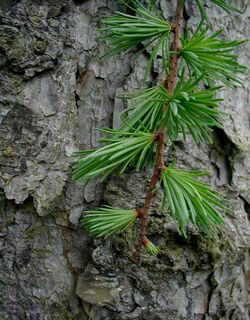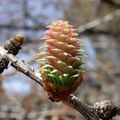Biology:Larix kaempferi
| Japanese larch | |
|---|---|

| |
| Bark and leaves | |
| Scientific classification | |
| Kingdom: | Plantae |
| Clade: | Tracheophytes |
| Clade: | Gymnospermae |
| Division: | Pinophyta |
| Class: | Pinopsida |
| Order: | Pinales |
| Family: | Pinaceae |
| Genus: | Larix |
| Species: | L. kaempferi
|
| Binomial name | |
| Larix kaempferi (Lamb.) Carr.
| |
Larix kaempferi, the Japanese larch[2] or karamatsu (唐松) in Japanese, is a species of larch native to Japan, in the mountains of Chūbu and Kantō regions in central Honshū.[3]
It is a medium-sized to large deciduous coniferous tree reaching 20–40 m tall, with a trunk up to 1 m diameter. The crown is broad conic; both the main branches and the side branches are level, the side branches only rarely drooping. The shoots are dimorphic, with growth divided into long shoots (typically 10–50 cm long) and bearing several buds, and short shoots only 1–2 mm long with only a single bud. The leaves are needle-like, light glaucous green, 2–5 cm long; they turn bright yellow to orange before they fall in the autumn, leaving the pinkish-brown shoots bare until the next spring.[3]
The cones are erect, ovoid-conic and 2–3.5 cm long, with 30–50 reflexed seed scales; they are green when immature, turning brown and opening to release the seeds when mature, 4–6 months after pollination. The old cones commonly remain on the tree for many years, turning dull grey-black.[3]
It grows at altitudes up to 2,900 m on well-drained soils, avoiding waterlogged ground.[citation needed]
The scientific name honours Engelbert Kaempfer. It is also sometimes known by the synonym Larix leptolepis.[4]
Uses
Japanese larch is an important tree in forestry plantations, being grown throughout central and northern Japan (north to Hokkaidō), and also widely in northern Europe, particularly Ireland and Britain. The wood is tough and durable, and is used for general construction work. Small larch poles are widely used for fencing.
Cultivation
Larix kaempferi is used for ornamental purposes in parks and gardens.[5] It is also widely used as material for bonsai.[6] The dwarf cultivars ‘Blue Dwarf’,[7] growing to 1.5 m (4.9 ft) tall and broad, and ‘Nana’,[8] growing to 1 m (3.3 ft) tall and broad, have gained the Royal Horticultural Society’s Award of Garden Merit.[9]
Diseases
In late 2009 Phytophthora ramorum or sudden oak death disease was first found in Japanese larch trees, in the England counties of Devon, Cornwall and Somerset.[10] The disease was found in Counties Waterford and Tipperary in Ireland the following year.[11]
Gallery
References
- ↑ Katsuki, T.; Luscombe, D (2013). "Larix kaempferi". IUCN Red List of Threatened Species 2013: e.T42312A2971556. doi:10.2305/IUCN.UK.2013-1.RLTS.T42312A2971556.en. https://www.iucnredlist.org/species/42312/2971556. Retrieved 19 November 2021.
- ↑ (xls) BSBI List 2007, Botanical Society of Britain and Ireland, https://bsbi.org/download/3542/, retrieved 2014-10-17
- ↑ 3.0 3.1 3.2 Farjon, A. (1990). Pinaceae. Drawings and Descriptions of the Genera. Koeltz Scientific Books ISBN:3-87429-298-3.
- ↑ "The Plant List - species in Larix". London: Royal Botanic Gardens, Kew. 2013. http://www.theplantlist.org/1.1/browse/G/Pinaceae/Larix/.
- ↑ "Larix kaempferi". Royal Horticultural Society. http://apps.rhs.org.uk/plantselector/plant?plantid=6239.
- ↑ D'Cruz, Mark. "Ma-Ke Bonsai Care Guide for Larix kaempferi". Ma-Ke Bonsai. http://makebonsai.com/guide/bonsailink.asp?quicklink=5034&name=Larix_kaempferi.
- ↑ "RHS Plantfinder - Larix kaempferi 'Blue Dwarf'". https://www.rhs.org.uk/Plants/75993/i-Larix-kaempferi-i-Blue-Dwarf/Details.
- ↑ "RHS Plantfinder - Larix kaempferi 'Nana' Neumann". https://www.rhs.org.uk/Plants/332686/i-Larix-kaempferi-i-Nana-Neumann/Details.
- ↑ "AGM Plants - Ornamental". Royal Horticultural Society. July 2017. p. 58. https://www.rhs.org.uk/plants/pdfs/agm-lists/agm-ornamentals.pdf.
- ↑ Forestry Commission webpage on Phytophthora ramorum
- ↑ "Disease found in Japanese Larch Trees in Ireland". Department of Agriculture, Food & the Marine. 17 August 2010. http://www.agriculture.gov.ie/press/pressreleases/2010/august/title,45756,en.html.
External links
- Larix kaempferi images at the Arnold Arboretum of Harvard University Plant Image Database
- Gymnosperm Database: Larix kaempferi
Wikidata ☰ Q147439 entry
 |










